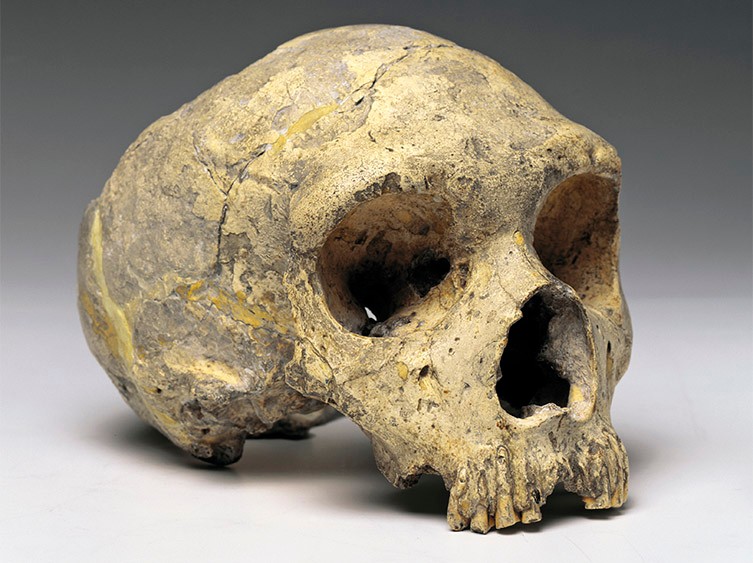Seriously! 42+ Truths About Neanderthal Skull Your Friends Forgot to Let You in!
Neanderthal Skull | Its significance wasn't recognised at first. Neanderthals (the 'th' pronounced as 't') are our closest extinct human relative. The neanderthal body was also stockier and shorter than ours. Neanderthal anatomy differed from modern humans in that they had a more robust build and distinctive morphological features, especially on the cranium, which gradually accumulated more derived aspects, particularly in certain isolated geographic regions. Modern humans have unusually globular skulls compared to our closest extinct cousins, the neanderthals, and a new study has identified two genes underlying this difference.
The neanderthal skull included a prominent, bony brow ridge and large, wide nostrils. Modern humans have unusually globular skulls compared to our closest extinct cousins, the neanderthals, and a new study has identified two genes underlying this difference. The skull was found in 1848 in a quarry in gibraltar. In a 1857 paper, german anatomist. The shape of your brain may say a lot about the neanderthal in you.

Its significance wasn't recognised at first. Some defining features of their skulls include the large middle part of the face, angled cheek bones. Neanderthal anatomy differed from modern humans in that they had a more robust build and distinctive morphological features, especially on the cranium, which gradually accumulated more derived aspects, particularly in certain isolated geographic regions. The skull was found in 1848 in a quarry in gibraltar. The neanderthal body was also stockier and shorter than ours. In a 1857 paper, german anatomist. Modern humans have unusually globular skulls compared to our closest extinct cousins, the neanderthals, and a new study has identified two genes underlying this difference. The shape of your brain may say a lot about the neanderthal in you. The neanderthal skull included a prominent, bony brow ridge and large, wide nostrils. Neanderthals (the 'th' pronounced as 't') are our closest extinct human relative. New research has found that previous research had suggested these contrasting skull shapes might reflect differences in the size.
The shape of your brain may say a lot about the neanderthal in you. Its significance wasn't recognised at first. Some defining features of their skulls include the large middle part of the face, angled cheek bones. The skull was found in 1848 in a quarry in gibraltar. The neanderthal body was also stockier and shorter than ours.
Neanderthals (the 'th' pronounced as 't') are our closest extinct human relative. Modern humans have unusually globular skulls compared to our closest extinct cousins, the neanderthals, and a new study has identified two genes underlying this difference. Neanderthal anatomy differed from modern humans in that they had a more robust build and distinctive morphological features, especially on the cranium, which gradually accumulated more derived aspects, particularly in certain isolated geographic regions. The neanderthal skull included a prominent, bony brow ridge and large, wide nostrils. The skull was found in 1848 in a quarry in gibraltar. The shape of your brain may say a lot about the neanderthal in you. New research has found that previous research had suggested these contrasting skull shapes might reflect differences in the size. The neanderthal body was also stockier and shorter than ours. In a 1857 paper, german anatomist. Its significance wasn't recognised at first. Some defining features of their skulls include the large middle part of the face, angled cheek bones.
Modern humans have unusually globular skulls compared to our closest extinct cousins, the neanderthals, and a new study has identified two genes underlying this difference. Its significance wasn't recognised at first. The shape of your brain may say a lot about the neanderthal in you. The skull was found in 1848 in a quarry in gibraltar. Some defining features of their skulls include the large middle part of the face, angled cheek bones.

Modern humans have unusually globular skulls compared to our closest extinct cousins, the neanderthals, and a new study has identified two genes underlying this difference. The skull was found in 1848 in a quarry in gibraltar. Some defining features of their skulls include the large middle part of the face, angled cheek bones. Neanderthal anatomy differed from modern humans in that they had a more robust build and distinctive morphological features, especially on the cranium, which gradually accumulated more derived aspects, particularly in certain isolated geographic regions. Neanderthals (the 'th' pronounced as 't') are our closest extinct human relative. The neanderthal skull included a prominent, bony brow ridge and large, wide nostrils. The neanderthal body was also stockier and shorter than ours. The shape of your brain may say a lot about the neanderthal in you. Its significance wasn't recognised at first. New research has found that previous research had suggested these contrasting skull shapes might reflect differences in the size. In a 1857 paper, german anatomist.
Neanderthal anatomy differed from modern humans in that they had a more robust build and distinctive morphological features, especially on the cranium, which gradually accumulated more derived aspects, particularly in certain isolated geographic regions neanderthal. The shape of your brain may say a lot about the neanderthal in you.
Neanderthal Skull: Neanderthal anatomy differed from modern humans in that they had a more robust build and distinctive morphological features, especially on the cranium, which gradually accumulated more derived aspects, particularly in certain isolated geographic regions.
Source: Neanderthal Skull
0 Response to "Seriously! 42+ Truths About Neanderthal Skull Your Friends Forgot to Let You in!"
Post a Comment